
[ad_1]
Buyers simply went by way of one of many hardest funding years in historical past. This was a marked change from the 2019-2021 interval which noticed robust inventory and bond returns regardless of the pandemic. The query on everybody’s thoughts is: “2022 was powerful, will 2023 be higher for buyers?”. I don’t like “year-ahead outlook” studies. I’ve learn a whole bunch of them through the years they usually’re usually out of date by the top of January. As an alternative of attempting to foretell what 2023 would possibly appear to be, I assumed I’d share what’s on our thoughts and the way which may have an effect on buyers within the New Yr.
How Dangerous Had been Funding Returns in 2022 In comparison with Historical past?
Inventory buyers have endured a number of years worse than what we noticed in 2022. The S&P 500 index simply averted bear market territory by ending 2022 -18.5%. There have been a half-dozen years worse than 2022 for the S&P 500.
What was really distinctive about 2022 for buyers is the efficiency of bonds. We’ve complete return information for intermediate-term U.S. Authorities bonds going again to 1926. By “intermediate-term,” I imply bonds that mature in 5-7 years. For these bonds, 2022 was the worst 12 months ever.
After we mix annual inventory and bond returns on a scatter plot, you’ll be able to see that 2022 was really an outlier.
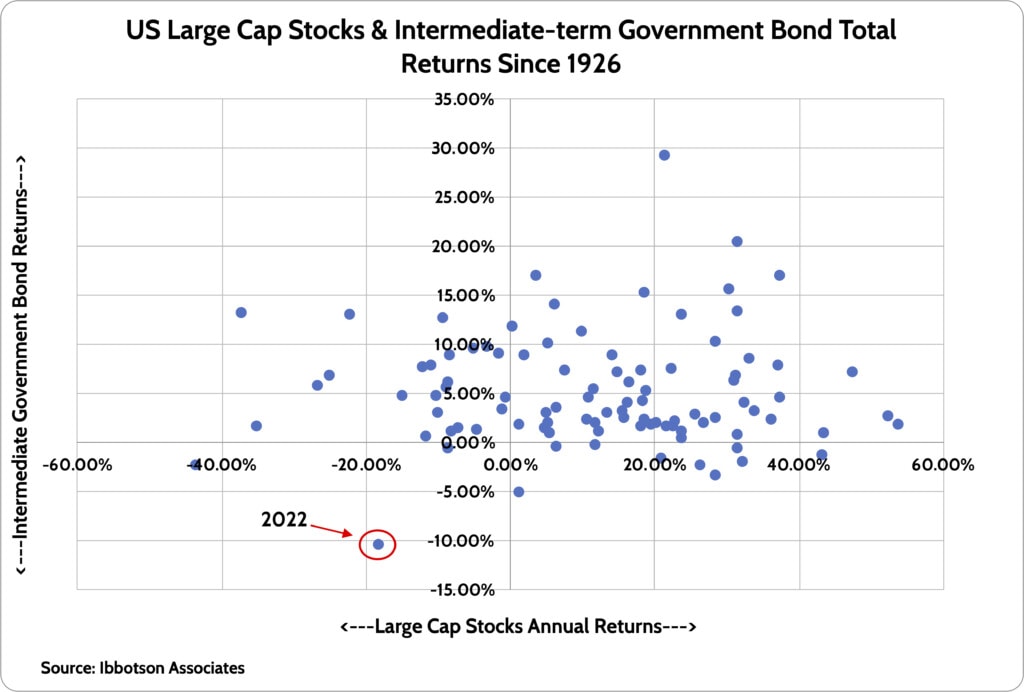
Why did bonds have such a horrible 12 months? It’s all due to the ‘unconventional’ financial coverage the Federal Reserve and different international central banks have engaged in because the Nice Monetary Disaster of 2008. By aggressively shopping for bonds as a part of their Quantitative Easing coverage, they pushed rates of interest to a few of their lowest ranges ever. One other approach to put that is that the Fed artificially boosted bond costs, which benefitted buyers and debtors for a few years.
One among my favourite charts to point out the madness of financial coverage from 2008 to 2021 is to take a look at the full worth of worldwide debt with NEGATIVE yields. After peaking at almost $18 trillion, the full worth of negatively yielding debt is quickly approaching zero.
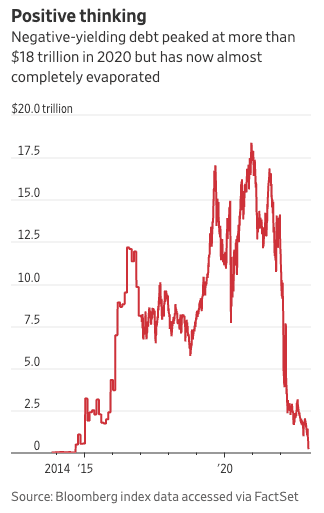
Unwinding this madness is the important thing purpose bonds suffered a lot in 2022. Going from extraordinarily low yields to extra regular yields meant decrease bond costs. I’ll speak concerning the outlook for charges a bit later.
What follows is a considerably random set of ideas that we predict are essential to buyers heading into 2023.
Will There Be a Recession in 2023?
There was a number of speak concerning the financial system being in recession in the course of 2022. Whereas official authorities statistics confirmed two quarters of financial contraction, there actually wasn’t a recession. Employment ranges are nonetheless very robust and client spending stays robust.
In current weblog posts I’ve talked concerning the potential for a recession in 2023. It might occur or it might not, or perhaps it doesn’t occur till 2024. Nevertheless it’s price explaining why I’ve that perception.
Crucial purpose is that the federal government bond yield curve is inverted. In plain English, bond buyers consider the Federal Reserve when it says it can hike short-term rates of interest in direction of 5.00% in 2023. However these identical buyers count on decrease rates of interest past two years. This implies a perception that the Fed should lower charges in some unspecified time in the future, which they solely do in recessions.
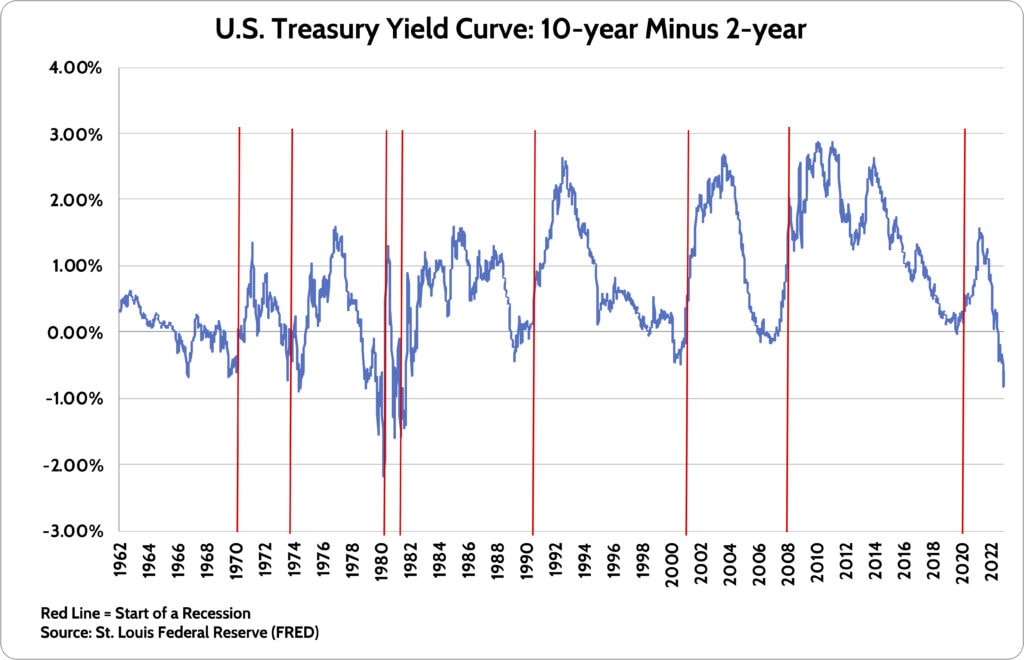
The above chart seems at the most typical means buyers have a look at the yield curve. 10-year authorities bonds are the market’s expectation of “regular” rates of interest. 2-year authorities bond yields are what the market really thinks financial coverage from the Fed will appear to be within the short-term.
The pink traces within the chart present the beginning of a recession. In the event you look intently, you’ll see that each time you see the blue line go under 0% (besides 1966) you see a pink line occur quickly after. In the present day’s yield curve is as inverted because it has been because the early Nineteen Eighties. That’s the final time we had an actual inflation battle on our arms.
Buyers must ask themselves, “Will this time be completely different?”. Will we keep away from recession after an inverted yield curve sign for the primary time in 52 years? My hunch is we gained’t.
This hunch is pushed by the very fact we’ve had probably the most aggressive rate of interest hike cycles on report. The U.S. financial system had operated with close to 0% charges for over a dozen years. Abruptly, we’ve gone from 0% to close 5% in 12 months.
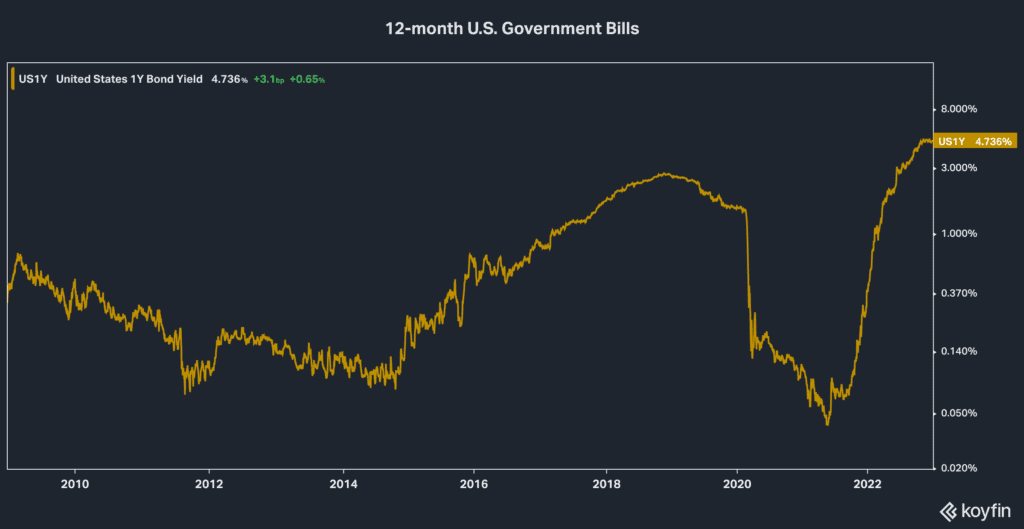
I don’t assume charges can go up this a lot this shortly with out consequence. Rates of interest drive the whole lot within the financial system. Residence costs and constructing exercise are going to take a success. Giant corporations that feasted on low cost debt to purchase again their inventory should pay that debt off or roll it over at a lot greater charges. The results are many.
Will the Fed “Pivot” and Cease Mountain climbing Charges??
The controversy du jour available in the market at present is when the Fed will cease mountain climbing rates of interest. Most individuals assume they are going to hike 2-3 extra instances in early 2023 after which cease. I’d agree with that evaluation.
What comes after that pause in price hikes is the true query. The overwhelming majority of at present’s buyers solely find out about one factor: the financial system goes into recession, the Fed cuts charges aggressively, and shares go up. That’s been the playbook for over twenty years.
My thesis is that it’s not that straightforward this time due to the inflation downside we now have. Certain, the inflation price will come down in 2023 as provide chains normalize and we lap a few of the enormous inflation we noticed in 2022. However I don’t assume we’re going again to a world of 1-2% inflation quickly.
The most important problem the Fed has economically and politically is the roles market. They know full properly that robust wage progress results in greater future inflation. And that’s precisely what we’re seeing with extraordinarily robust wage progress, significantly for these within the backside half of wage earners.
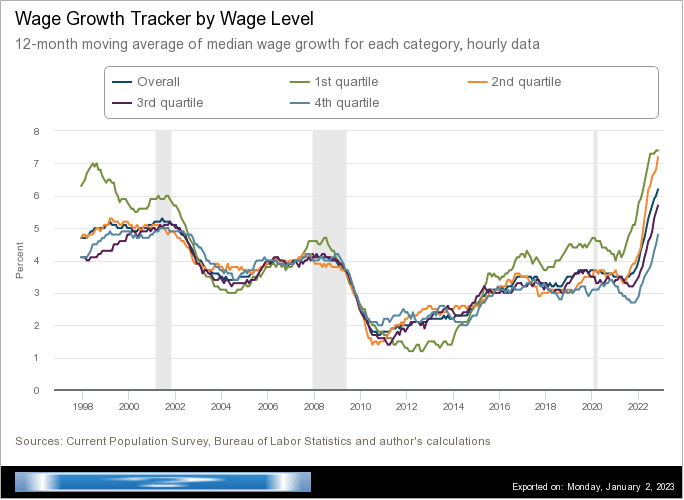
Summarizing:
1) Inflation is a gigantic downside for the financial system…
2) Rate of interest hikes have performed nothing to loosen up labor markets. As evidenced by a really low unemployment price and powerful wage progress…
3) The longer the labor market stays tight, the upper the chances are of a “wage-price spiral” in coming years, which might hold inflation excessive…
This places the Fed in a tough place. In the event that they pause price hikes and the financial system continues to hum together with low unemployment, then future inflation is prone to be greater due to robust wage positive aspects for employees. Then what? Let’s converse the reality out loud: The Fed desires folks to lose jobs so the labor market loosens up, wage progress slows, and inflation falls again to their made-up “goal” of two% inflation. That’s the unvarnished fact, one thing you’ll by no means hear out of their mouths due to the political firestorm that may ensue.
The danger I see for the market in 2023 is that the Fed might be pressured to hike charges greater than 5.0% and hold them there for longer than buyers count on. Bond buyers are baking in rate of interest cuts of 1.00% by the center of 2024. I’m not one to battle the market. However that appears hopelessly optimistic absent a extreme recession and spike within the unemployment price.
A possible recession and the trail of Federal Reserve coverage are the 2 headwinds that inventory buyers face in 2023. If the financial system is powerful and a recession doesn’t occur, then the Fed will hold charges excessive, which is a headwind for shares. But when a recession occurs, then shares would battle with the drop in firm earnings. Very like 2022, we proceed to see the stability of dangers outweighing potential rewards for shares.
Excessive High quality Bonds Ought to Carry out Higher in 2023
The outlook for Bonds seems higher heading into 2023. Truthfully, it could possibly’t actually worsen than it was in 2022. My reasoning for anticipating higher efficiency from Bonds is that short- and long-term rates of interest are at far more cheap (and better) ranges than they had been a 12 months in the past.
Increased rates of interest equals much less bond worth threat, not like final 12 months. On January 1, 2023, an investor can earn 4.75% on a one-year, risk-free authorities bond. Boring financial savings accounts at some on-line banks will now pay you shut to three.30%. Briefly, buyers are getting paid to do nothing with their cash for the primary time in almost 15 years.
JP Morgan Asset Administration publishes a useful chart exhibiting the potential impression on bond returns from a 1% rise/fall in rates of interest. As you’ll be able to see, the worth threat from a 1.00% rise in rates of interest is small. That’s until you’re invested in very long-term bonds equivalent to 30-year U.S. Treasury bonds.

Trying on the chart, it seems like bonds of every type are nice values. However I don’t assume that’s the case. For ultra-safe U.S. Treasury bonds (above: “USTs”) I’m constructive on the return outlook for 2023. However after we’re speaking about company bonds, leveraged loans, and excessive yield “junk” bonds, the outlook stays unsure.
Non-government bonds are influenced by the extent of rates of interest AND the perceived credit score threat of these bonds in comparison with risk-free authorities bonds. The “unfold” between the yield you earn on a non-government bond in comparison with a authorities bond can considerably have an effect on investor returns.
With a possible recession on the horizon, warning is warranted with non-government bonds. If a recession occurs, then the “unfold” I simply spoke about will rise. This can negatively impacts the costs of non-government bonds.
The excellent news for FDS shoppers is that we’ve taken steps over the past 18 months to scale back rate of interest threat AND credit score threat in shopper bond portfolios. Whereas we’re seeing growing worth in longer-term authorities bonds which might be delicate to rates of interest, it feels early to “chase yield” in non-government bonds, as tempting because the rates of interest is likely to be.
Will 2023 Be Higher for Buyers?
Given the warning above, it’s no shock that we proceed to take a cautious strategy with shopper investments. Essentially the most notable transfer befell on the tail-end of the summer time rally in shares. Then, we moved 10% of shopper funds out of shares and into cash market funds which now yield 4%.
Utilizing money as a strategic funding allocation instrument will proceed into 2023. The ‘price’ of sitting in money is rather a lot decrease than what it was when everybody was incomes 0% on their financial savings.
As famous above, there’s growing worth in elements of the bond market. Relying on the place longer-term rates of interest go, we might search so as to add rate of interest threat (“period”) again to bonds. These had been first lowered two years in the past. It should most likely take a while to see higher worth within the non-government bond area. However we’re at all times able to reap the benefits of alternatives after we see them.
Lastly, on the shares facet of the ledger, we predict being nimble in including & decreasing shares publicity might be the secret. Markets have confirmed fairly risky and given the financial uncertainties on the market, we wouldn’t be stunned to see that proceed.
Shares aren’t a screaming worth, to be frank. Numerous the big cap know-how fluff that surged in 2020 and 2021 got here down dramatically in 2022. Nonetheless, that doesn’t imply these shares are low cost.
Quite a bit will rely upon whether or not we now have a recession and the way deep the revenue recession might be for Company America. Shares hardly ever discover a backside till buyers are comfy they will see a backside on company profitability.
One of many hardest issues about investing is being affected person. As I scan the blogs I’ve written over the past 2+ years, they at all times appear to have a adverse bent to them. That’s not as a result of I’m a adverse individual! We’re in probably the most essential shifts within the funding atmosphere in our lifetimes. That takes time to play out.
Worth will emerge throughout the funding panorama in some unspecified time in the future. And we’ll be comfortable to “go lengthy” when that occurs. However at FDS, defending our shoppers is job #1. Your goals, your targets, your monetary life are to not be trifled with. We are able to’t assure something for shoppers. However we may give it our all daily to assist transfer the chances in shoppers’ favor.
[ad_2]